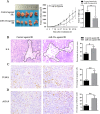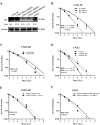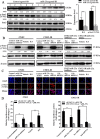MiR-23a sensitizes nasopharyngeal carcinoma to irradiation by targeting IL-8/Stat3 pathway
- PMID: 26314966
- PMCID: PMC4695064
- DOI: 10.18632/oncotarget.5117
MiR-23a sensitizes nasopharyngeal carcinoma to irradiation by targeting IL-8/Stat3 pathway
Abstract
Radioresistance poses a major challenge in nasopharyngeal carcinoma (NPC) treatment, but little is known about how miRNA regulates this phenomenon. In this study, we investigated the function and mechanism of miR-23a in NPC radioresistance, one of downregulated miRNAs in the radioresistant NPC cells identified by our previous microarray analysis. We observed that miR-23a was frequently downregulated in the radioresistant NPC tissues, and its decrement correlated with NPC radioresistance and poor patient survival, and was an independent predictor for reduced patient survival. In vitro radioresponse assays showed that restoration of miR-23a expression markedly increased NPC cell radiosensitivity. In a mouse model, therapeutic administration of miR-23a agomir dramatically sensitized NPC xenografts to irradiation. Mechanistically, we found that reduced miR-23a promoted NPC cell radioresistance by activating IL-8/Stat3 signaling. Moreover, the levels of IL-8 and phospho-Stat3 were increased in the radioresistance NPC tissues, and negatively associated with miR-23a level. Our data demonstrate that miR-23a is a critical determinant of NPC radioresponse and prognostic predictor for NPC patients, and its decrement enhances NPC radioresistance through activating IL-8/Stat3 signaling, highlighting the therapeutic potential of miR-23a/IL-8/Stat3 signaling axis in NPC radiosensitization.
Keywords: IL-8; Stat3; miR-23a; nasopharyngeal carcinoma; radioresistance.
Conflict of interest statement
The authors disclose no potential conflicts of interest.
Figures







Similar articles
-
MiRNA-203 Reduces Nasopharyngeal Carcinoma Radioresistance by Targeting IL8/AKT Signaling.Mol Cancer Ther. 2015 Nov;14(11):2653-64. doi: 10.1158/1535-7163.MCT-15-0461. Epub 2015 Aug 24. Mol Cancer Ther. 2015. PMID: 26304234
-
MiR-125b Increases Nasopharyngeal Carcinoma Radioresistance by Targeting A20/NF-κB Signaling Pathway.Mol Cancer Ther. 2017 Oct;16(10):2094-2106. doi: 10.1158/1535-7163.MCT-17-0385. Epub 2017 Jul 11. Mol Cancer Ther. 2017. Retraction in: Mol Cancer Ther. 2018 Nov;17(11):2490. doi: 10.1158/1535-7163.MCT-18-0938. PMID: 28698199 Retracted.
-
MicroRNA-19b-3p regulates nasopharyngeal carcinoma radiosensitivity by targeting TNFAIP3/NF-κB axis.J Exp Clin Cancer Res. 2016 Dec 5;35(1):188. doi: 10.1186/s13046-016-0465-1. J Exp Clin Cancer Res. 2016. PMID: 27919278 Free PMC article.
-
The Role of Cyclin d1 in Radiotherapy Resistance of Advance Stage Nasopharyngeal Carcinoma: A Systematic Review.Asian Pac J Cancer Prev. 2024 Jul 1;25(7):2211-2218. doi: 10.31557/APJCP.2024.25.7.2211. Asian Pac J Cancer Prev. 2024. PMID: 39068551 Free PMC article.
-
miRNA as promising theragnostic biomarkers for predicting radioresistance in cancer: A systematic review and meta-analysis.Crit Rev Oncol Hematol. 2021 Jan;157:103183. doi: 10.1016/j.critrevonc.2020.103183. Epub 2020 Nov 27. Crit Rev Oncol Hematol. 2021. PMID: 33310279
Cited by
-
Multiple Mechanisms Involving in Radioresistance of Nasopharyngeal Carcinoma.J Cancer. 2020 Apr 25;11(14):4193-4204. doi: 10.7150/jca.39354. eCollection 2020. J Cancer. 2020. PMID: 32368302 Free PMC article. Review.
-
MicroRNA-23a/24-2/27a as a potential diagnostic biomarker for cancer: A systematic review and meta-analysis.Mol Clin Oncol. 2018 Jan;8(1):159-169. doi: 10.3892/mco.2017.1492. Epub 2017 Nov 8. Mol Clin Oncol. 2018. PMID: 29387410 Free PMC article.
-
Integrative Analysis Identified a 6-miRNA Prognostic Signature in Nasopharyngeal Carcinoma.Front Cell Dev Biol. 2021 Jul 16;9:661105. doi: 10.3389/fcell.2021.661105. eCollection 2021. Front Cell Dev Biol. 2021. PMID: 34336826 Free PMC article.
-
Involvement of Non-Coding RNAs in Chemo- and Radioresistance of Nasopharyngeal Carcinoma.Cancer Manag Res. 2021 Nov 23;13:8781-8794. doi: 10.2147/CMAR.S336265. eCollection 2021. Cancer Manag Res. 2021. PMID: 34849030 Free PMC article. Review.
-
miRNA-148b regulates radioresistance in non-small lung cancer cells via regulation of MutL homologue 1.Biosci Rep. 2016 Jun 30;36(3):e00354. doi: 10.1042/BSR20150300. Print 2016 Jul. Biosci Rep. 2016. Retraction in: Biosci Rep. 2021 Apr 30;41(4):BSR-20150300_RET. doi: 10.1042/BSR-20150300_RET. PMID: 26759383 Free PMC article. Retracted.
References
-
- Lo KW, To KF, Huang DP. Focus on nasopharyngeal carcinoma. Cancer Cell. 2004;5:423–428. - PubMed
-
- Kristensen CA, Kjaer-Kristoffersen F, Sapru W, Berthelsen AK, Loft A, Specht L. Nasopharyngeal carcinoma. Treatment planning with IMRT and 3D conformal radiotherapy. Acta Oncologica. 2007;46:214–220. - PubMed
-
- Lee AW, Poon Y, Foo W, Law SC, Cheung FK, Chan DK, Tung SY, Thaw M, Ho JH. Retrospective analysis of 5037 patients with nasopharyngeal carcinoma treated during 1976-1985: overall survival and patterns of failure. Int J Radiat Oncol Biol Phys. 1992;23:261–270. - PubMed
-
- Garzon R, Calin GA, Croce CM. MicroRNAs in cancer. Annu Rev Med. 2009;60:167–179. - PubMed
-
- Chaudhry MA. Radiation-induced microRNA: Discovery, functional analysis, and cancer radiotherapy. J Cell Biochem. 2014;115:436–449. - PubMed
Publication types
MeSH terms
Substances
LinkOut - more resources
Full Text Sources
Other Literature Sources
Miscellaneous

